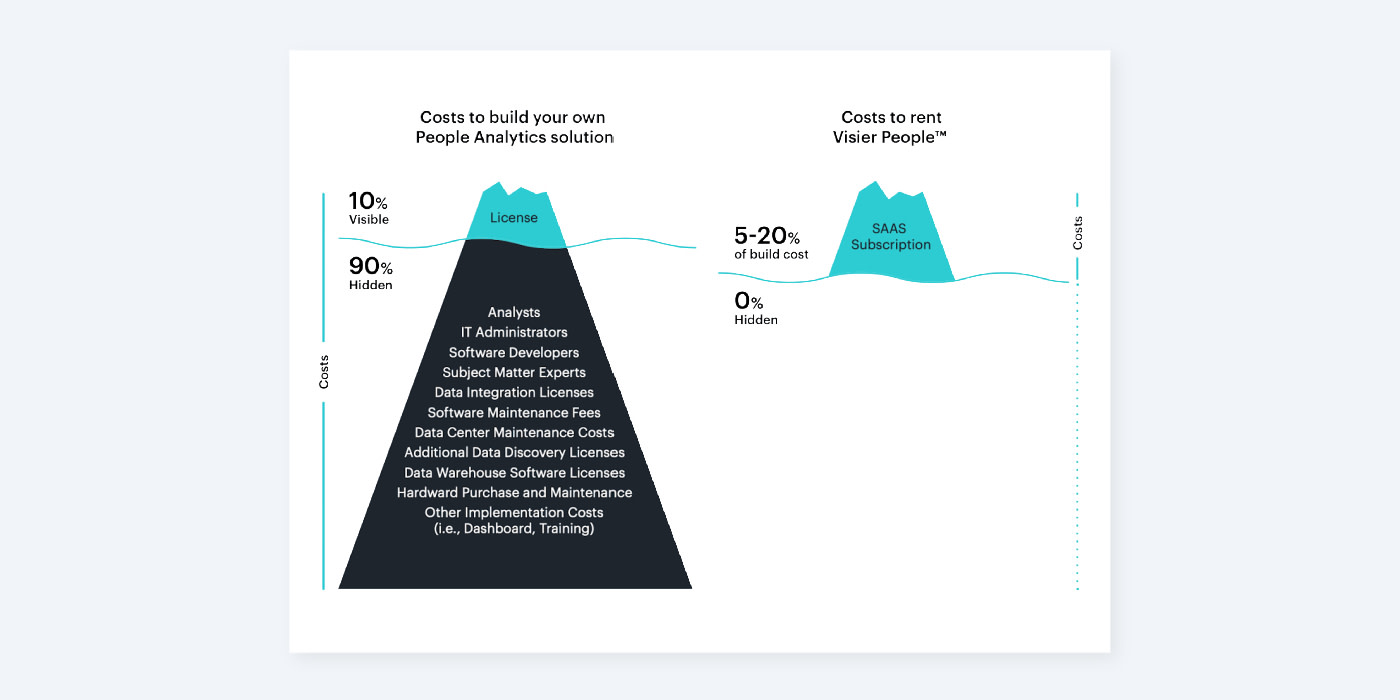Build vs. Rent: Don’t Crash on the Do-It-Yourself Iceberg for People Analytics
Build vs. Rent is a dichotomy in tech buying, but what does it mean when applied to people analytics? Should you build your people analytics solution?

“Build vs. Rent” is a common dichotomy in technology buying, but what does it mean when applied to people analytics? What should you be aware of before committing to one path or the other?
The race to adopt people analytics is heating up: according to the Bersin by Deloitte HR Technology Disruptions for 2018 report, “people analytics is now a must-have discipline within HR and business.”
But, as more and more HR organizations grow their analytics function, I’ve noticed that not all journeys are the same. While the same talent challenges are spurring companies to become more data-driven in workforce decision making, the approaches they are taking fall mainly into two different camps: build or rent.
Building your People Analytics Solution
Recently, I learned about a large software organization’s quest to build a people analytics solution. The goal was to better enable HR and business leaders to make talent decisions that would have an impact on the business. To achieve this, the company hired an HR business intelligence team, standardized their reporting metrics, and invested over $3 million in a data warehouse and business intelligence (BI) software.
This company took the “Build” route to people analytics — a traditional approach that with modern tools, like Tableau, Qlik, or TIBCO, may initially look cost effective, and even “easy.” However, the purchase of a few relatively inexpensive BI licenses is just the tip of the iceberg: there are many more costs and complexities “below the waterline” that are only revealed the further you go.
According to a recent report by Gartner, which compares the total three-year BI platform ownership costs across vendors, vendor types, and deployment sizes: “Buying low license cost platforms does not always translate into low business intelligence platform ownership cost (BIPOC) over time or into higher business benefits.”*
In fact, if you isolate the purchase of the initial BI tool licenses, you are looking at just 10% of the total cost of the platform being built — the tip of the iceberg.
What seems like a straightforward toolset purchase at the beginning turns out to be a much larger and costlier project, requiring:
Additional Data Discovery licenses
Hardware purchase and maintenance
Data warehouse software licenses
Data integration tools licenses
Data center maintenance costs
IT administrators
Subject Matter Experts to determine questions to ask
Analysts to determine metric definitions and create reports
Software developers to build each output
Software maintenance fees
Other implementation costs, such as the development of dashboards and training
Why is this the case with the build path?
BI vendors, whether they sell Data Discovery, Data Integration, or Data Warehouse tools, are focused on providing their technology to you as a toolset. The actual work to build a people analytics solution that is tailored to meet your needs — such as answering questions about recruiting, employee retention and engagement, or diversity and inclusion — requires you or a vendor you hire to develop the solution from the ground up. Some BI toolsets might provide “starter packs,” to help you get going, but ultimately, you must still design and develop your own solution, integrate your data, and perform ongoing maintenance and updates.
Once the costs of the necessary hardware, software, development, IT, and admin requirements are added together, enterprise companies will have typically spent millions of dollars on an implementation that might have looked low-cost and quick at the start.
And this only includes the workforce analytics component of the solution. A true people analytics solution will also be part of a people strategy platform that enables data-driven workforce planning — a capability set not supported by BI tools.
Fortunately, there is an alternate path — one that is becoming recognized as a leading practice — where everything involved with the people analytics iceberg is known and taken care of upfront at a fraction of the cost: the “Rent” option.
Renting your People Analytics Solution
Software-as-a-Service (SaaS) refers to software that is licensed or “rented” to customers for use over the web or in the cloud. This means your costs are transparent and fixed (although you need to vet this, as not all SaaS solutions are the same), and the risks associated with managing your own BI project are removed.
A SaaS solution for people analytics should work “out of the box” and can be rented for a fraction of the cost to build a BI solution. At Visier, we refer to this as “add data and stir.” However, not all solutions are equal — and it is important to understand what services are provided as part of your SaaS fee, and what you are expected to do yourself.
Be sure to check the following services and capabilities are included in your fixed SaaS subscription fee to ensure no hidden costs:
Virtual Big Data Warehouse (What do you need to do to get your data onboarded into this warehouse?)
Data integration (How much will the vendor do for you? How much must you do? What happens if you need to add or switch data sources?)
Data discovery (Is this all done for you?)
Workforce metrics, analytics, and visualization (What is the scope of the content provided to you?)
Workforce planning capabilities (What is the scope of the capabilities provided to you?)
Product updates
Ongoing data management, maintenance, and support
Secure hosting in the cloud
Ensure your SaaS solution for people analytics also doesn’t limit the number of users due to cost. To enable true adoption of a data-driven mindset in your organization, you need to make “self-service access” to insights widely available.
Comparing Build vs. Rent Head-to-Head
Let me illustrate the differences between the Build and Rent paths by returning to our example of the software company from earlier.
The chart below shows the company situation after three years of building their own solution:

The costs and benefits of building a people analytics solution
Their progress looks good having reached the strategic level on the “People Analytics Maturity Curve.” However, the money invested and the staffing levels required are significant. They currently support only 200 users, yet have a 15-person analytics team: a team size even large enterprises can only dream of, and a team five times larger than necessary — the benchmark is one analytics team member per 3500 staff in an organization. To support more users at the same level, they must spend even more money, hire more members to their analytics team, and buy more toolset licenses and hardware.
On the other hand, a Fortune 500 company opted for the Rent option in their data-driven journey and implemented Visier. These were their results, compared to the software company that followed the Build path:

Visier build versus rent cost and benefits chart
This side-by-side comparison shows the advantages of choosing the rent option for the datafication of your HR function. Our iceberg example illustrates this point as well:

Visier iceberg analysis showing the difference in costs between building your own people analytics solution and renting Visier People
If you look at just estimated staffing costs, the difference in team size alone demonstrates the efficacy of the “Rent” option. Forrester Consulting found that Yahoo experienced a cost savings of over $2.2 million because renting enabled a cost avoidance of 10 FTEs.
Keep Scalability Top of Mind
When assessing the path you want to take, scalability is an important factor. What can get a result in the short term is unlikely to serve your longer-term goals. Time and time again, we’ve had customers tell us that once they showed their people analytics solution to business leaders, everyone wanted to get their hands on it. If they didn’t have a SAAS solution, it would have cost more than the organization was willing to invest to provide self-serve analytics to the full enterprise.
To borrow from Stephen Covey: “Begin with the end in mind.”
*Gartner, Survey Analysis: Customers Rate Their Business Intelligence Platform Ownership Cost, Rita L. Sallam, Josh Parenteau, Cindi Howson, Ehtisham Zaidi, 27 August 2015


